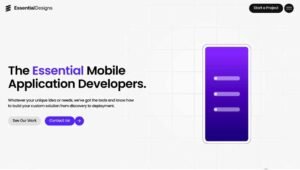Personalization in web and app development is now a necessity for businesses looking to boost user engagement and satisfaction. Here’s why it matters and how it works:
- Why it matters: Over 70% of consumers expect tailored experiences, and personalization directly increases customer loyalty and revenue. For example, returning customers spend 67% more than new ones.
- What it is: Custom development creates software that aligns with specific business needs, eliminating unnecessary features and focusing on what users actually want.
- Industries benefiting: E-commerce, healthcare, finance, education, and more are leveraging personalized software to meet unique challenges.
- Key benefits: Better user experiences, improved business efficiency, and stronger security practices are direct outcomes of tailored solutions.
- How to implement: Understand user needs, design intuitive interfaces, and refine through testing and feedback.
Personalization is reshaping how businesses connect with users, making software experiences more relevant and impactful. Companies like Netflix and Amazon are leading the way, proving that tailored solutions are the future of user engagement.
Case Study AI Driven Personalization in UX Design
Main Benefits of Personalization in Web and App Development
Personalization enhances user satisfaction, improves operational workflows, and strengthens security measures.
Better User Experience and Higher Satisfaction
When interfaces are tailored to individual preferences, users experience a smoother, more intuitive interaction. Software that adapts to specific behaviors and needs removes unnecessary obstacles, making every engagement feel meaningful.
A recent study revealed that 75% of executives prioritize personalization in digital experiences, while 90% of customers are willing to pay more for a tailored onboarding process [2]. These numbers highlight how much people value personalized interactions.
Personalization doesn’t just improve the experience – it makes onboarding easier. For example, 86% of users say effective onboarding and educational tools are key to turning them into loyal customers [2]. Apps like Grammarly and Duolingo ask users to set goals and preferences from the start. This approach not only creates a more relevant experience but also addresses a major issue: 80% of users delete apps due to usability problems [2]. With AI-driven tools, personalization takes another leap, predicting user behavior and adjusting content and layouts in real time. These dynamic features lead to higher engagement and better conversion rates [1].
By improving user experiences, businesses also unlock smoother operations.
More Efficient Business Operations
Personalized software solutions simplify processes in ways that generic tools cannot. By automating tasks and centralizing functions, businesses can reduce inefficiencies that drain resources.
Operational inefficiencies cost companies between 20% and 30% of their annual revenue [3]. Personalized software aligns with specific business needs, addressing bottlenecks and repetitive tasks. For instance, a logistics company implemented 200 automation solutions, saving 78,815 workdays and over $6 million [3]. Similarly, automating invoice processing reduced costs from $6.20 per invoice to just $1.45 – a 76% savings [3].
Beyond cost reductions, custom solutions improve collaboration. Centralized platforms give teams a shared space to work together and access real-time data [4]. Unified dashboards streamline multiple functions into one interface, increasing efficiency [5]. These tools also consolidate data from various sources, offering a complete view of operations and enabling better decision-making [4]. Additionally, 66% of employees report that automating repetitive tasks reduces errors, freeing them to focus on strategic projects [3]. Custom solutions are built to scale, ensuring businesses can maintain these efficiency gains as they grow [4].
Better Security and Regulatory Compliance
Personalized software doesn’t just enhance user experiences and operations – it also provides stronger security. Custom applications are designed to address specific risks, offering a level of protection that off-the-shelf solutions can’t match.
Tailored security protocols and compliance tools keep data safe and meet regulatory standards. Companies that invest in custom software report a 65% boost in productivity thanks to automated and streamlined security processes [7]. Businesses using custom solutions are also three times more likely to outperform competitors and achieve long-term growth [7].
Custom apps can enforce specific controls, automate compliance checks, and simplify reporting with audit trails and integration into regulatory frameworks [7]. For example, a regional bank developed a custom mobile app with biometric authentication and real-time transaction monitoring. This not only reduced fraud but also boosted customer trust and ensured compliance with regulatory standards through automated reports and improved encryption [6]. With real-time threat monitoring and advanced security features, personalized software gives businesses greater control over their data and compliance efforts compared to generic alternatives [8].
How to Build Personalized Web and Mobile Applications
Creating personalized web and mobile applications involves a clear, user-centered approach. By focusing on user needs at every stage, developers can craft applications that enhance engagement and satisfaction. The process includes understanding user requirements, designing intuitive interfaces, and refining the experience through continuous feedback.
Gathering User Requirements and Needs
The first step to building a personalized application is understanding what users truly need. This goes beyond just listing desired features – it’s about identifying key stakeholders, clarifying business objectives, and documenting requirements thoroughly.
“The quality of a mobile app’s requirements document can make or break the project. It doesn’t only consist of a list of features, it gives you the foundation upon which your future app is built.” – Anton Baryshevskiy, CBDO at Mind Studios [9]
Engage with business owners, end-users, and decision-makers to uncover real pain points and priorities. A helpful tool here is the use of user stories, structured as: “As a [user], I want [goal] so that [benefit].” These stories keep the focus on delivering value to users. Prioritizing the most critical needs ensures that essential features are developed first.
Creating User-Focused Interface Designs
Once the requirements are clear, the next step is to translate them into user-friendly designs. A well-designed interface emphasizes simplicity, consistency, and ease of use. Research shows that nearly 60% of users won’t recommend a business with a poorly designed mobile site, and close to 40% will disengage if the layout is unappealing [10].
Consistency across platforms is key to building trust. For example, using uniform buttons, colors, and navigation patterns helps users feel comfortable and reduces the learning curve. Standard navigation elements like tab bars for iOS or navigation drawers for Android provide familiarity. Features like autocomplete, input masks, and dynamic validation minimize user effort, making the experience smoother. Responsive designs ensure the app works seamlessly across devices, while accessibility features – like sufficient color contrast, keyboard navigation, and screen reader compatibility – make the app inclusive for all users.
Visual hierarchy also plays a big role in guiding users. Strategic use of size, color, and contrast helps highlight important information, ensuring users can easily find what they need. Once the design is in place, thorough testing ensures it meets user expectations.
Testing and Improving Your Application
Testing is vital for ensuring that personalized applications perform as intended. A mix of automated and manual testing helps identify potential issues early, saving time and resources. Developing a detailed test plan – covering scope, timeline, and specific test cases – adds structure to the process.
Usability testing provides valuable insights by observing how real users interact with the app. A/B testing different versions of personalized features can also drive improvements. For instance, Contorion used A/B testing to increase conversion rates by 5% and split URL testing to boost add-to-cart click rates by 2.4% [11].
Feedback from users is another powerful tool. In-app surveys, feedback forms, and user interviews can reveal how well personalization features are working. Studies show that active user feedback can increase engagement by over 25% [12].
Performance optimization is equally critical. Yelp, for example, improved browser rendering by 45%, leading to a 15% boost in conversion rates [11]. Behavioral analytics can identify how users interact with personalized features, potentially increasing engagement rates by up to 30% [12]. Regular updates to personalization algorithms and offering users control over personalization settings can further improve retention by up to 30% [12].
Establishing feedback loops, where users can share their experiences and see improvements, is essential. This approach has been shown to make 80% of users more likely to return to an app [12]. By continually refining the app based on real user input, developers can secure long-term engagement and deliver on the promise of personalized applications.
How Essential Designs Creates Personalized Software Solutions

Essential Designs crafts software solutions tailored to meet the specific needs of their clients. By combining strategic planning with agile practices, they transform unique requirements into effective digital experiences. Their expertise spans development, design, and long-term support, all aimed at enhancing user interaction and satisfaction.
Custom Web and App Development Services
Essential Designs excels in creating solutions designed for various platforms and industries. Their development process is methodical, covering planning, wireframing, design, coding, testing, and deployment. By using Agile methodology, projects are divided into manageable sprints, allowing for regular client input and adjustments throughout the development lifecycle.
Some standout projects include a responsive EHSC web application for Teck Resources, a healthcare-focused safe-consumption platform for Lifeguard and BCHES, and a global license key management system for Honeywell. For healthcare applications, such as the Lifeguard platform, personalization isn’t just a feature – it’s a lifesaving necessity.
“Essential Designs was able to create a cutting-edge application that will save lives, they always say ‘Anything can be done’ and are definitely able to deliver on that promise.”
– Jeff Hardy, Founder, Lifeguard [13]
Another example of their versatility is the My Trade Shop mobile app. This all-in-one solution caters to both businesses and customers, providing tailored experiences for different user groups within a single framework.
UI/UX Design for Personalized Experiences
Once development begins, user-centered design takes priority. Essential Designs places user feedback at the heart of their process, ensuring that features align with real needs. They gather insights through various methods, including surveys, interviews, user testing, data analysis, and social media monitoring [14].
Their design process is iterative, evolving based on continuous feedback. Early-stage input allows them to identify and address potential issues before they become costly problems. Feedback is prioritized based on factors like its impact, frequency, and technical feasibility, ensuring that critical personalization features are addressed first.
“We’ve been engaged with Essential Designs for several years now, and we’ve found that the value they deliver is significantly above everyone else that we deal with.”
– Rick Twaddle, SBA, Teck Resources [13]
Collaboration with stakeholders is a cornerstone of their approach. This ensures that personalized interface elements are implemented seamlessly without disrupting the overall user experience. For global clients such as Schneider Electric, Essential Designs has demonstrated the ability to create solutions that cater to diverse markets and user groups.
“We are a company present in more than 150 countries… I was very happy with their efficiency… they were responsive and happy to make any changes that we required.”
– Kirill Kudymov, Product Manager, Schneider Electric [13]
Long-term Support and Maintenance
Essential Designs doesn’t stop at launching a product. They provide ongoing support to ensure that personalized solutions continue to adapt and thrive. Their comprehensive services include troubleshooting, maintenance, upgrades, and clear communication channels [15].
Their maintenance efforts focus on resolving issues promptly, adapting to evolving needs, and refining functionality to prevent future problems. Regular updates keep software stable and reliable, while performance optimization ensures smooth operation of personalization features.
Effective database management plays a crucial role in securely storing and quickly accessing user preferences and behavior data. Essential Designs offers flexible support options, such as on-demand assistance, ongoing maintenance, and custom support plans, to meet diverse client needs [15]. This flexibility is particularly important for personalized applications, where user bases often have varying demands.
As businesses grow, Essential Designs ensures that software evolves alongside them. They add features to scale with increasing user bases and shifting market needs. Continuous improvements to UX/UI, informed by user feedback, keep the experience fresh while preserving the personalized elements that drive engagement.
“I had a lot of trust in them, everyone knew their job, and they worked very efficiently… the trust and communication skills were what distinguished them from their competitors.”
– Cristen Phipps, Owner, Handld [13]
Custom software often requires more specialized care than off-the-shelf solutions. Essential Designs’ commitment to long-term support ensures that these complex systems remain reliable while adapting to new challenges and user expectations. This approach not only meets immediate goals but also fosters sustained engagement and satisfaction over time.
How to Measure Success of Personalized Solutions
Once you’ve implemented personalized solutions, the next step is figuring out if they’re actually making a difference. Tracking the right data points can help you see whether your custom web and app development efforts are truly driving user engagement and delivering meaningful results.
Important Metrics for User Engagement
User engagement metrics are like a roadmap – they show how users interact with your personalized application and highlight areas that might need fine-tuning. These metrics help developers understand what’s resonating with users and what might need a second look.
- Session duration: This tells you how long users are staying on your app. If personalization is working, users will spend more time exploring features that align with their preferences.
- Feature adoption rates: These rates show which personalized elements users engage with versus the ones they ignore.
- User retention rates: Are users coming back after their first visit? Strong personalization should make the experience so relevant that users want to return.
- Conversion rates: This measures how many users complete key actions, like making a purchase or signing up for a service.
Here’s a telling statistic: 73% of app users expect their individual needs to be understood [16]. That’s why satisfaction scores are a must-have metric – they help you understand how well your personalization efforts are meeting user expectations.
Another strategy is segmenting your audience into different user groups. Why? Because not all users respond to personalization in the same way. By analyzing engagement across different segments, you can pinpoint what’s working and tailor your approach even further.
While these quantitative metrics are essential, they only tell part of the story. To get a complete picture, you need to hear directly from your users.
Getting User Feedback for Improvements
Numbers are important, but user feedback adds depth to your understanding. It helps you uncover why certain features are a hit and why others might be falling flat – insights you won’t always get from data alone.
- In-app feedback: This method captures users’ thoughts in real time, while they’re actively interacting with your app. It’s more effective than traditional surveys because the experience is still fresh in their minds [17].
- Ease of feedback collection: Make it simple. Take Dealfront as an example – they added feedback widgets to their interface using Userpilot, allowing users to flag data issues with just a click. This resulted in a 50% survey completion rate and major improvements in data accuracy [17].
- Contextual feedback: Asking for feedback immediately after a specific interaction ensures you get actionable insights. Keeping requests short and focused makes it easier for users to respond.
- Multiple feedback channels: Not everyone likes giving feedback the same way. Some users prefer quick rating buttons, while others want to leave detailed comments. Offering a range of options makes it easier for users to share their thoughts.
And don’t forget the follow-up. When users see their input reflected in app updates, it builds trust and encourages them to keep sharing their thoughts. This kind of feedback loop is invaluable for refining personalization features.
Comparing Results Before and After Implementation
To see if your personalization efforts are paying off, you need to compare results before and after implementation. Start by establishing baseline metrics – this gives you a clear point of reference for measuring improvement.
Interestingly, research from Forrester shows that only 30% of companies have the right metrics in place to measure the success of their personalization programs [18]. That’s a missed opportunity for many businesses.
Let’s look at some examples:
- Bear Mattress redesigned their cross-sell flow and personalized recommendations based on purchase history. The result? A 16% increase in revenue [18].
- Sephora SEA introduced an augmented reality (AR) feature for trying on makeup. By pairing it with step-by-step videos and push notifications, they saw a 28% boost in user adoption and a 48% rise in traffic to the AR feature [19].
- American Dairy Queen Corporation tested different welcome offers and rolled out the most successful one nationwide. This led to a 138% revenue increase compared to their average monthly performance. According to McKinsey, personalization can cut customer acquisition costs by up to 50% and improve marketing ROI by 10–30% [19][20].
Using dashboards to display metrics side-by-side makes it easier to track trends and measure long-term impact. Segmenting results by user groups or specific personalization strategies can also reveal which approaches work best for different audiences, giving you a deeper understanding of what drives success.
Conclusion: The Future of Personalization in Software Development
In today’s digital world, personalization isn’t just a nice-to-have – it’s a must. The numbers back this up: 84% of customers say that feeling like a person, not just a number, is critical to earning their business [23]. This shift in what consumers expect means businesses can no longer rely on cookie-cutter, one-size-fits-all approaches.
And the companies embracing personalization? They’re seeing big wins. Take Adidas, for example. During the COVID-19 pandemic, they boosted their average order value by 259% and saw a 35.5% jump in conversion rates for returning users – all thanks to targeted coupon codes. On top of that, they increased mobile conversion rates by 50.3% simply by personalizing mobile menus based on browsing behavior [24]. McKinsey adds to this with findings that personalized experiences can drive a 5–15% increase in revenue while making marketing spend up to 30% more efficient [25]. These results make it clear: personalization isn’t just a trend – it’s the way forward.
Key Takeaways for Businesses
Effective personalization hinges on expert software development. The technical effort involved – think AI-powered tools and real-time data processing – requires skills many businesses don’t have in-house.
“Personalization differentiates digital marketing by meeting customers’ unique preferences.” – Varun Goel [22]
This is where companies like Essential Designs come into play. Their approach focuses on creating scalable, flexible solutions tailored to grow alongside your business. Instead of locking you into rigid systems, they build modular architectures that can adapt as your personalization needs evolve.
Even small tweaks can have a big impact. For instance, personalized call-to-action buttons outperform generic ones by 202% [21]. But it’s not just about results – security and compliance are just as important. Since personalization relies heavily on user data, working with developers who prioritize privacy regulations and build strong security measures is crucial. This proactive approach helps businesses avoid costly compliance mistakes.
What’s Next for Personalized Software?
The benefits of personalization are clear, but emerging technologies are set to take things even further. Generative AI, for example, is making scalable, customized content creation more accessible than ever [24]. AI-driven predictive analytics are also shifting personalization from reactive to proactive, anticipating what customers want before they even ask.
Privacy-conscious consumers are driving another trend: zero-party data collection. By directly asking users for their preferences, businesses can deliver more accurate personalization while building trust [24]. At the same time, low-code and no-code platforms are making it easier for companies to implement these strategies. Gartner predicts that by 2025, 70% of new enterprise apps will be built using these platforms [28].
The demand for custom software in the U.S. reflects this shift, with the market expected to grow at a compound annual growth rate (CAGR) of 18.5% from 2024 to 2030 [26]. Cloud-native architectures are also becoming the norm, with 85% of businesses projected to adopt a “cloud-first strategy” by 2025 [27]. And let’s not forget edge computing, which is enhancing real-time interactions by processing data closer to users – perfect for mobile apps and location-based services.
Meanwhile, the Internet of Behavior (IoB) is opening up new ways to understand user preferences through connected devices. However, this also raises the stakes for ethical data use and transparent privacy practices.
“Machines are evolving from being our tools to becoming our teammates … Gartner predicts that by 2025, GenAI will be a workforce partner for 90% of companies worldwide.” – Gabriela Vogel, Sr Director Analyst, Gartner [27]
As these technologies evolve, personalization will become more advanced and automated. But the human touch – truly understanding your customers and aligning with their needs – will remain irreplaceable. The businesses that thrive will be those that combine cutting-edge technology with thoughtful strategy and ethical practices.
FAQs
What are the best ways for businesses to collect and analyze user feedback to improve personalization in web and app development?
Businesses have several ways to collect user feedback, including usability testing, in-app surveys, and customer support interactions. They can also study user behavior through analytics tools. These methods reveal important details about user preferences, challenges, and expectations.
To make sense of the feedback, it’s crucial to organize the data, spot patterns, and focus on the most pressing areas for improvement. Using tools like feedback templates or analytics platforms can simplify this process. Additionally, regular A/B testing and continuous monitoring help ensure that personalization efforts stay effective and aligned with what users need.
What steps can businesses take to keep their custom software secure and compliant with regulations?
To ensure custom software remains secure and meets regulatory requirements, businesses should focus on robust security measures. This includes using encryption, following secure coding standards, and conducting regular vulnerability assessments. Keeping up with regulations like HIPAA, GDPR, and CCPA is equally important to stay compliant.
Key steps to protect sensitive information include implementing multi-factor authentication, setting up access controls, and maintaining detailed audit logs. Regularly training employees on data privacy and conducting routine security checks can further reduce potential risks. Lastly, keeping comprehensive compliance documentation ensures you’re ready for audits or any regulatory changes.
How does customizing web and app experiences improve customer loyalty and drive business growth?
Personalizing web and app experiences helps build stronger customer loyalty by making users feel understood and valued. When a platform aligns with their preferences and needs, users are more inclined to stay engaged and keep coming back. This translates into better retention rates and increased lifetime value.
For businesses, personalization is a powerful growth driver. It enhances user satisfaction, boosts revenue, and often leads to larger purchases. In fact, research indicates that tailored experiences can lead to a 10-15% increase in revenue and significantly improve customer engagement. By prioritizing customization, companies not only improve the user experience but also set the stage for sustainable success.












